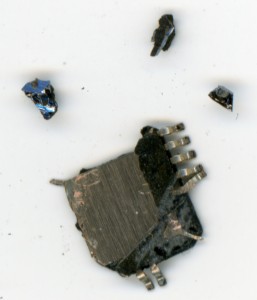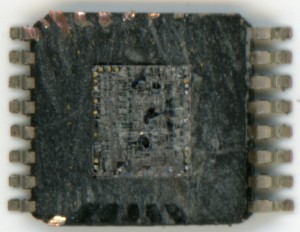April 26
2010
Sparkfun Atmega328P not "Slugs"
I managed to get 15 of the “slugs” from sparkfun.com
I heated one up till it became brittle and cracked apart

Turns out they are not just a piece of copper!
there is gold and silicon in them :)

looked more impressive under my microscope at 3x you could see there was actual circuitry on the silicon.
little gold wires connecting the pins to the silicon barely visible in the scan
Second attempt
Filed down the chip then used acetone to make the plastic weak so i could chip it away easy with an exacto knife

now the real question.. what is the chip really?
curiouser and curiouser.
No mystery. Chip manufacturing failure is quite normal. Early Pentium chips were in the high 50% failure range coming off the line.
Those chips are simply thrown away. These are probably rejects that were scooped out of the garbage and resold to a shifty supply house. After being sourced through several places, they ended up at Adafruit…
Er… Sorry… /sold to Sparkfun/… My feeds are blending together in Google Reader… :-)
No mystery. Chip manufacturing failure is quite normal. Early Pentium chips were in the high 50% failure range coming off the line.
Those chips are simply thrown away. These are probably rejects that were scooped out of the garbage and resold to a shifty supply house. After being sourced through several places, they ended up at Adafruit…
Yes, failure is quite normal, especially early in production. However, most of these failures are identified at probe and are not packaged. Why waste money packaging defective silicon?
Yes, but how are they with picante sauce?
“Early Pentium chips were in the high 50% failure range coming off the line.”
WT??? LOL!… Actual history was the Math co-processor in the “Pentium” Chips were coded faulty… Nothing but a bunch of 000’s. You had to prove that you needed the co-processor in them to get a replacement. Eventually replacements were made available for the ones that had the problem.
Interesting enough, what company produced these fake Atmega328P chips???
I support a number of silicon vendors. I have encountered re-marked parts on numerous occasions. Usually the parts were purchased through brokers. The practice of grinding the top or the IC and re-marking is not uncommon in some parts of the world.
Chris, they are referring to the yield of the manufacturing process. Not the actual packaged chips that were sold.
Just for the record
http://www.sparkfun.com/commerce/news.php?id=395